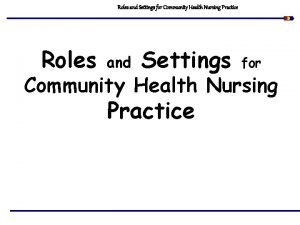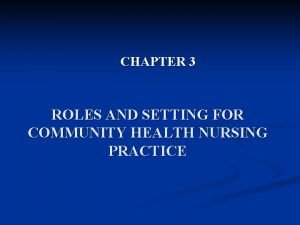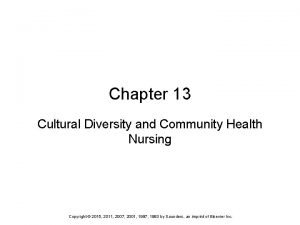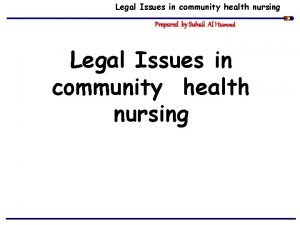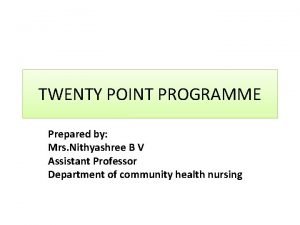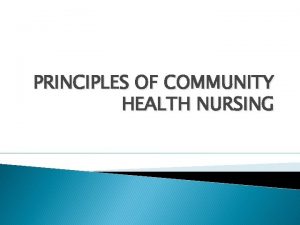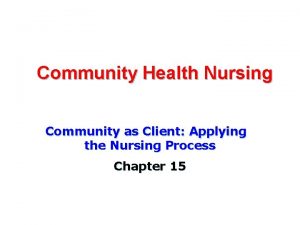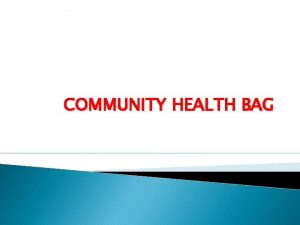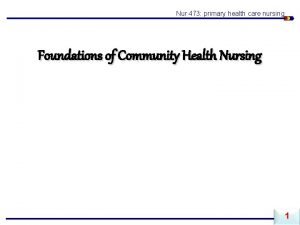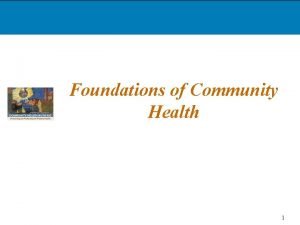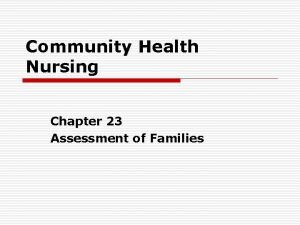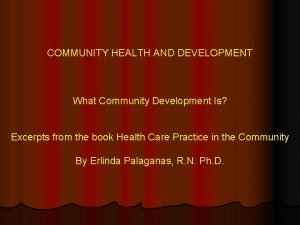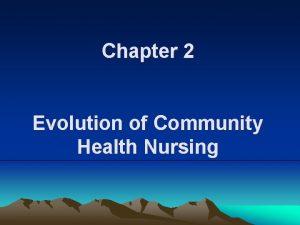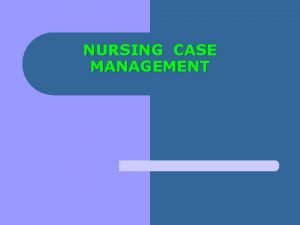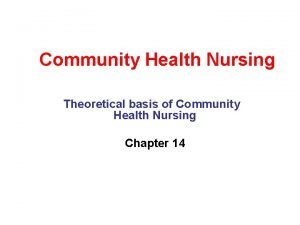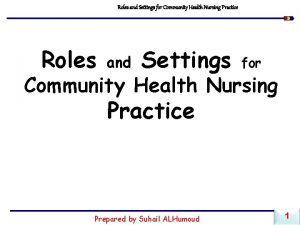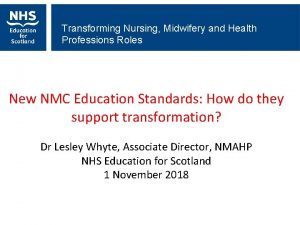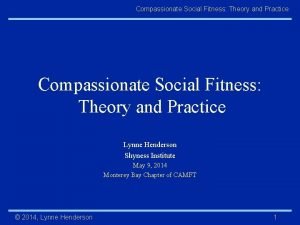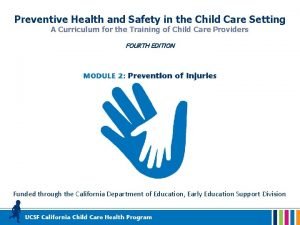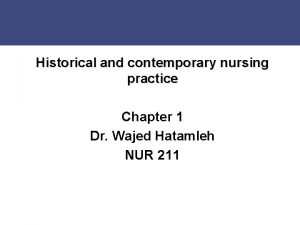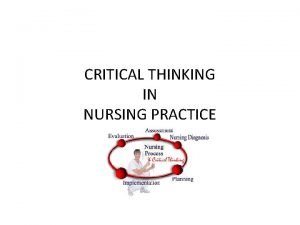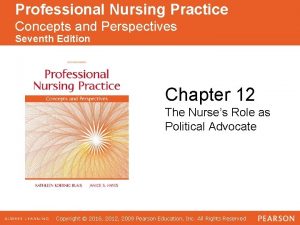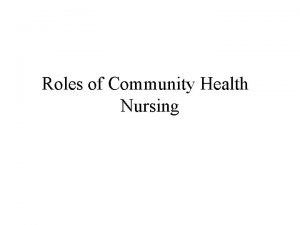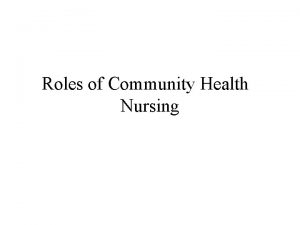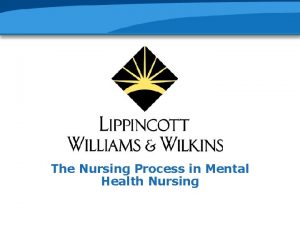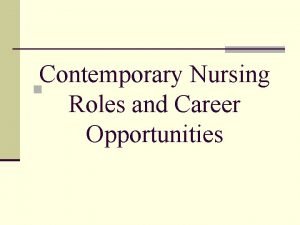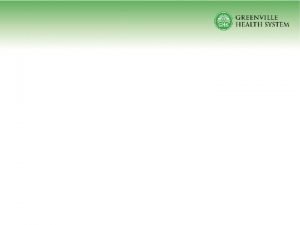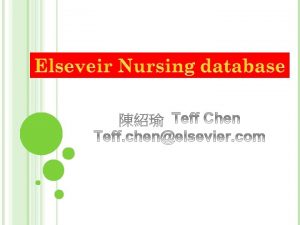ROLES AND SETTING FOR COMMUNITY HEALTH NURSING PRACTICE













































- Slides: 45

ROLES AND SETTING FOR COMMUNITY HEALTH NURSING PRACTICE

ROLES OF COMMUNITY HEALTH NURSES n The seven major roles of a community health nurse are:

1. Care provider. "Clinician role". n 2. Educator. n 3. Advocate. n 4. Manager. n 5. Collaborator. n 6. Leader. n 7. Researcher. n

1. Care Provider "Clinician Role" n The most familiar role of the community health nurse is that of clinician or care provider. The clinician role in community health means that the nurse ensure that health services are provided not just to individuals and families, but also to groups and populations.

2. Educator Role A second important role of the community health nurse is that of educator or health teacher. Health teaching is one of the major function of the community health nurse. n The educator role is especially usefulness in promoting the public's health for at least two reasons: n

n n n 1. Community clients usually are not actually ill and can absorb and act on health information. For example: - A class of expectant parents, unhampered by significant health problems, can grasp the relationship of diet to fetal development. They understand the value of specific exercises to childbirth process, are motivated to learn, and are more likely to perform those exercises. Thus, the educator has the potential for finding greater receptivity and providing higher-yield results.

2. The educator role in community health nursing is significant because a wider audience can be reached. n With an emphasis on population and aggregates, the educational efforts of community health nursing care appropriately targeted to reach many people. n

3. Advocate Role n n The issue of clients' rights is important in health care. Every patient or client has the right to receive, just, equal, and human treatment. Our current health care system often is characterized by fragmented and depersonalized services, and many clients-especially the poor, the disadvantaged, those without health insurance, are denied their rights. They become frustrated, confused, degraded, and unable to cope with the system on their own.

n n n The community health nurse often acts as an advocate for clients, pleading their cause or acting on their behalf, Clients may need some one : - To explain which services to expect, which services they ought to receive. -To make referrals as needed. -To write letters to agencies or health care providers for them. - To assure the satisfaction of their needs.

4. Manager Role n n n n n Community health nurses, like all nurses, engage in the role of managing health services. As a manager, the nurse exercises administrative direction toward the accomplishment of specified goals by: - Assessing client's needs. - Planning and organizing to meet those needs. - Controlling and evaluating the progress to ensure that goals are met. The nurse serves as a manger when: - Overseeing client care as a case manager. - Supervising ancillary staff. - Running clinics. - Conducting community health needs assessment projects.

5. Collaborator Role n Community health nurses seldom practice in isolation. They must work with many people, including: -

- The clients. Other nurses. Physicians teachers. Health educators. Social workers. Physical therapist. - Nutritionist. Occupational therapist. Psychologist. Epidemiologist. - Biostatisticians. - Attorneys. - Secretaries. Environmentalist. City planners

As members of health team, community health nurses assume the role of collaborator, n Which means to work jointly with others in a common endeavor, to cooperate as partners. n Successful community health practice depends on his multidisciplinary collegiality and leadership. n

6. Leadership Role Community health nurse are becoming increasingly active in the leadership role, the leadership role focuses on affecting change, thus the nurse becomes an agent of change. n As leaders, community health nurse seek to initiate changers that positively affect people's health. n

They also seek to influence people to think and behave differently about their health and the factors contributing to it. n At the community level, the leadership role may involve working with a team of professionals to direct and coordinate such projects as a campaign to eliminate smoking in public areas. n

7. Researcher Role n In the researcher role, community health nurses engage in systematic investigation, collection, and analysis of data for solving problems and enhancing community health practice.

SETTING FOR COMMUNITY HEALTH NURSING PRACTICE n n n n The setting in which the community health nurses are practiced their different roles are grouped into six categories: 1. Homes. 2. Ambulatory service settings. 3. Schools. 4. Occupational health settings. 5. Residential institutions. 6. The community at large.

1. Homes For long time, the most frequently used setting for community health nursing practice was the home. n In the home, all of the community health nursing role's , to varying degrees, are performed. n

n Clients who are discharged from acute care institutions, such as hospitals or mental health facilities, are regularly referred to community health nurses for continued care and follow-up. Here, the community health nurse can see clients in a family and environment context, the service can be tailored to the client's unique needs.

The home also is a setting for health promotion. Many community health nursing visits focus on assisting families to understand practice healthier living behaviors. n Nurses may, for example, instruct clients on parenting infant care, child discipline, diet, exercise, coping with stress. n

n In the home, unlike most other health care setting, clients are on their own turf. they feel comfortable and secure in familiarity surroundings and often are better able to understand apply health information. Client self-respect can be promoted, because the client is host and the nurse is a gust.

Home visit A home visit is a purposeful interaction in a home directed at promoting and maintaining the health of individuals and the family ( or significant others). 22 15/07/43

Advantage n n n n Home setting provides for individualized care. Most people prefer to cared for at home. Effective observation (environment factors such as house condition , finances). Information collection and understanding lifestyle value are easy. Participation of family members is facilitated health care. Reducing overall costs in cases of caring ill family members. Decrease or minimize anxious in their own environment. 23 15/07/43

Disadvantage: Travel time is costly. n Less efficient for nurse that working with groups. n Difficult to deal with emergency cases n Difficult to control distraction such as noisy children , television. n Clients may be resistant or fearful for the intimacy of home visits. n Nurse safety can be an issue n 24 15/07/43

Phases of Home Visit: 1. Preplanning 2. Initiation 3. Implementation 4. Termination 5. Post home visit and preplanning Or: 1. pre visit preparation 2. Making the visit 3. Concluding and documenting the visit. 25 15/07/43

On locating and meeting the family, the following guidelines for initial contact should be used: 1. introduce yourself and explain the value to the family of the nursing services provided by the agency. 2. spend the first few minuets of the visit establishing cordiality and getting acquainted. 3. use acute observational skills. 4. be sensitive to verbal and non verbal cues. 5. be adaptable and flexible.

6. use your sixth sense as a guide regarding family responses questions they ask and your personal safety. 7. be aware of your own personality ; balance talking and listening , and be aware of your non verbal behaviors. 8. Be aware that most clients are not acutely ill and have higher level of wellness than are usually seen in acute care settings.

9. become acquainted with all family members and household members if you are making a home visit. 10. encourage each person to speak for himself or her self. 11. be accepting and listen carefully.

12. help the family focus on issues and move toward desired goals. 13. after the body of the visit is over review the important points, emphasizing family strength. 14. plane with the family for the next visit.

Friction between family members: During a home visit two or more family members may begin to argue or physically fight with one another. immediately remove yourself from the home visit and tell the family members that you will visit at another time when the family differences are resolved. (mean: TO BE ASSERTIVE)

3. Schools

Responsibilities of School Nurse n n n n n School nurse: A specialty branch of professional nursing that serves the school-age population. The National Association of School Nurses (NASN) created seven roles to describe their practice. The school nurse: 1. Provides direct healthcare to students and staff. 2. Provides leadership for the provision of health services. 3. Provides screening and referral for health conditions. 4. Promotes a healthy school environment 5. Promotes health. 6. Serves in a leadership role for health policies and programs. 7. Serves as a liaison between school personnel, family, community and health care providers

The primary responsibility of the school nurse are to prevent illness and to promote and maintain the health of the school community. n The school nurse serves not only individuals, families, and groups within the context of school health but also the school as an organization and its membership 9 students and staff) as aggregates. n

The school nurse is responsible for providing a broad range of services, including the following eight components of a coordinated school health program: - 1. Health services: Serves as the coordinator of the health services program, provides nursing care, and advocates for health rights. n - Health services include programs such as : n - Vision and hearing screening. n - Scoliosis screening. n - Monitoring of height, weight and blood pressure. n

n n n n - Oral health. - TB screening. - Immunization assessment and monitoring medication administration. - Care of children with specialized health care needs. - First aid. - Assessment of acute health problem. - Health examinations ( especially for athletic participation or school entry).

n 2. Health education: Provides appropriate health information that promotes informed healthcare decisions, promotes health, prevents disease, and enhances school performance.

3. Environment: Identifies health and safety concerns in the school community, promotes a safe and nurturing school environment. n The function of the school nursing practice is the promotion of healthful school living. Emphasis on healthful physical environment includes: n

4. Nutrition: Supports school food service programs and promotes the benefits of healthy eating patterns. Safety of food service , school breakfast and lunches. n 5. Physical education/activity: Promotes healthy activities, physical education, and sports policies/practices that promote safety and good sportsmanship. n

n n 6. Counseling/mental health: Provides health counseling, assesses mental health needs, provides interventions, refers students to appropriate school staff or community agencies, and provides follow-up once treatment is prescribed. 7. Parent/community involvement: Promotes community participation in assuring a healthy school and serves as school liaison to a health advisory committee.

n 8. Staff wellness: Provides health education and counseling, promotes healthy activities and environment for school staff.

What is a Healthy Community? The following descriptors can serve as a guide for assessing a healthy community. The healthy community characterized by: 1. 2. Is one in which members have a high degree of awareness that "we are a community". Uses natural resources wisely while taking steps to conserve them for future generations.

3. 4. 5. Openly recognizes the existence of subgroups and welcomes their participation in community affairs. Is prepared to meet crises. Is a problem-solving community; it identifies, analyzes, and organizes to meet its own needs.

6. 7. 8. 9. Has open channels of communication that allow information to flow among all subgroups of citizens in all directions. Seeks to make each of its systems' resources available to all members of the community. Has legitimate and effective ways to settle disputes that arise within the community. Encourages maximum citizen participation in decision-making

Contraindications to Immunization

q. Permanent Contraindication to Vaccination Ø Anaphylaxis or a sever hypersensitivity reaction is an absolute contraindication to subsequent dose of a vaccine. Persons with a known allergy to a vaccine component should not be vaccine. Ø Encephalopathy following pertussis vaccine and/or persistent crying lasting 3 or more hours occurring within 48 hours of dose or seizure with or without fever occurring within 3 days of dose. Ø Do not give BCG or Yellow vaccine to an infant that exhibits the sign and symptoms of AIDS. Ø If a parent strongly objects to an immunization for a sick infant, do not give it. ask the mother to come back when infant is well.
 Goals of community health nursing
Goals of community health nursing Main roles of community setting
Main roles of community setting Culturological assessment
Culturological assessment Legal aspects of community health
Legal aspects of community health 20 points program ppt
20 points program ppt Nursing process benefits
Nursing process benefits Parts of nursing diagnosis
Parts of nursing diagnosis 12 principles of community health nursing
12 principles of community health nursing Nursing process definition
Nursing process definition Psych nursing care plan examples
Psych nursing care plan examples Nursing community diagnosis examples
Nursing community diagnosis examples Community health definition
Community health definition Historical development of chn
Historical development of chn Purpose of home visiting in community health nursing
Purpose of home visiting in community health nursing Definition of primary health care services
Definition of primary health care services Home visit meaning
Home visit meaning Characteristics of community health nursing
Characteristics of community health nursing Family care plan in community health nursing
Family care plan in community health nursing Importance of community health nursing
Importance of community health nursing Evolution of community health
Evolution of community health Components of rch program
Components of rch program Function of community health nursing
Function of community health nursing Arthropods in community health nursing
Arthropods in community health nursing Salmon white's construct for public health
Salmon white's construct for public health Components of community health nursing
Components of community health nursing Conclusion of community mental health nursing
Conclusion of community mental health nursing Distribution in epidemiology
Distribution in epidemiology Professional nursing practice concepts and perspectives
Professional nursing practice concepts and perspectives Role and responsibility of occupational health nurse
Role and responsibility of occupational health nurse Function of community
Function of community 3 settings in chn
3 settings in chn Hildegard peplau modell
Hildegard peplau modell Transforming nursing roles
Transforming nursing roles Compassion theory
Compassion theory Understanding jim crow (setting the setting)
Understanding jim crow (setting the setting) Practice assessor feedback examples
Practice assessor feedback examples Preventive health and safety in the child care setting
Preventive health and safety in the child care setting Setting health goals and making responsible decisions
Setting health goals and making responsible decisions Historical and contemporary issues in nursing
Historical and contemporary issues in nursing Critical thinking in nursing practice
Critical thinking in nursing practice Professional nursing practice concepts and perspectives
Professional nursing practice concepts and perspectives Team nursing and modular nursing
Team nursing and modular nursing Formuö
Formuö Typiska novell drag
Typiska novell drag Tack för att ni lyssnade bild
Tack för att ni lyssnade bild Vad står k.r.å.k.a.n för
Vad står k.r.å.k.a.n för
